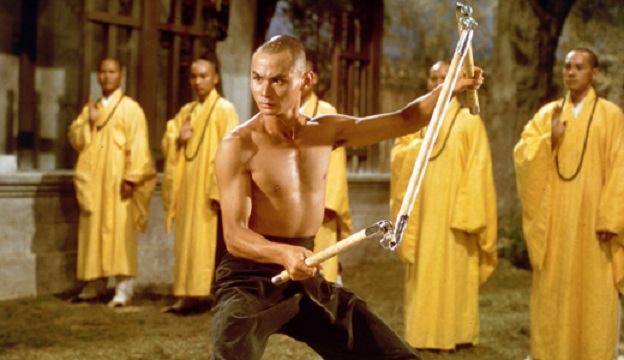The 36th Chamber of Shaolin
If you were able to see only one martial arts film in your lifetime, you might consider something like ENTER THE DRAGON, possibly THE STREETFIGHTER. I was a devotee of many Bruce Lee, Chuck Norris, and Sonny Chiba epics in my earlier years, always keen to ignore their deficiencies. Until a few years ago, I had never heard of 1978's THE 36TH CHAMBER OF SHAOLIN, revered by many notables as the greatest kung fu film ever made. This may not sound like an impressive attribute, given the genre's tendency for low standards. Many films in this category quite willingly stage wall to wall fights with only the barest of characterization, or even a single element of serious theme or subtext. They exist only to show off expert kicks and nunchuck swinging.
36TH CHAMBER is something different, though it does sport those patented hysterical zoom close-ups. Also, exaggerated sound effects of swooshing air and body slapping, not to mention all of the "Ooooooo-wahhhhh" type yells by its combatants. The story line is essentially no different than less ambitious such movies - young man trains to learn how to exact revenge on those who killed his loved ones. But this film elevates the genre with its middle section - a lengthy, thorough examination of a clumsy youth's transformation to master warrior, yet with consideration of the tenets of the Buddhist monks who train him. Many films feature a carefully edited montage of training; THE 36TH CHAMBER OF SHAOLIN spends over forty minutes following student Liu Yude (Liu Chia-Hui, who also directed) step by step as he acquires (and even creates) several impressive techniques in the study of kung fu.
Like many novices, he's eager/anxious to get right to hand to hand combat and weaponry. Liu seethes and is driven as he remembers the slaughter of his teacher and classmates at the hands of the Manchu dynasty in his town. He barely survives their attacks, but manages to reach the Shaolin temple, a place comprised of thirty-five chambers and where he quickly learns that he knows nothing of true, focused discipline and hard work. Of mental preparation and intuitiveness. He fails his first test - jumping on a small log in a pool of water to reach the dining hall. After much humiliation, he not only completes the task but devises a new, completely unorthodox way to master it. As Liu, later dubbed San Te after years of training, rapidly advances through formidable challenges; he continues to think outside each chamber, impressing his instructors and perhaps inspiring jealousy from his classmates.
The movie spends its first section setting up the story with adequate exposition, but the film really kicks in and earns its cred during those training scenes. Each chamber in the temple presents a different task, testing strength of every bone and muscle and even one's ability at optokinesis. Lest you think the movie just plays like an episode of American Ninja Warrior, Liu sections 36TH CHAMBER with as much emphasis on spiritual maturity, death to self, etc. as to feats of strength. The aggregate of this film becomes almost poetic in its journey.
Interestingly, it also eschews the usual gratuitous cuttaway elements of naked women and sex scenes, which cluttered many Bruce Lee pics. Gotta get those young audiences, ya know. No profanity, either. It's as if THE 36TH CHAMBER OF SHAOLIN is as disciplined and pure as its subjects, those who've devoted their lives to the art. The later scenes allow San Te to show what he's learned, and for all the Shawscope glory of his fists of fury, there's as much intellect on display as bone crushing. There's even the timeless observation that some folks would rather escape into the oblivion of alcohol than fight for their people.
But San Te will have a new goal after vengeance, to train the laypeople in the ways of the Shaolin.



Comments